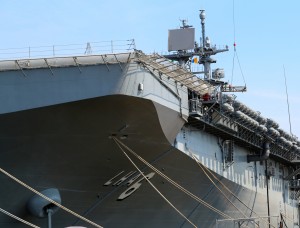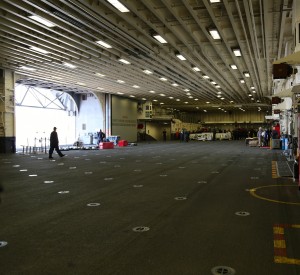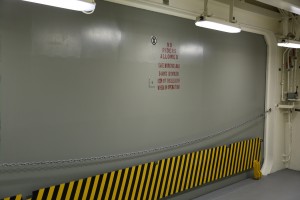2014-06-15 by Robbin Laird
The discussions of the USS America, although few and far between, have really focused on one of two issues:
What it does not have, namely a well deck
Or that it is an aircraft carrier at 50,000 plus tons and competes with the large deck carrier and makes it obsolete.
While both subjects deserve their place, what gets lost in the shuffle is the crucial issue of what exactly is the USS America?, it is clear that the USS America is something radically new: it is a 21st century assault ship.
It is part of the overall process of innovation, and not some well-deck less aberration.

While one analyst referred to the USS America as providing a “niche” capability, in reality it is a niche, which provides a sledgehammer for the fleet.
And a truly unique one, which is built for the USMC as the only tiltrotar, enabled force in the world.
The range and speed of the Osprey and the pairings with the KC-130J have led to the formation of a radical innovation, namely the SP-MAGTF-CR. And with it the ability to operate a great distances, the force can influence events more rapidly and with more agility than hitherto.
For example, in late December 2013, an SP-MAGTF embarked from Spain for South Sudan on a noncombat evacuation mission (NEO). 160 Marines and Sailors from the Special Force Marine Air Ground Task Force Crisis Response were flown by 2 KC-130s Hercules and 4 MV-22B Ospreys from Spain where they are temporarily based to Djibouti and then Uganda.
With 3,400 nautical miles (flying distance from Denver to Honolulu) this was the longest-range insert ever performed by this force thanks to its self-deployable capability.

The range and speed of the Osprey have generated pressures to shape new ways to empower the Ground Combat Element coming off of the Ospreys.
The GCE coming off the Osprey is not the same as coming off of a rotorcraft; the force needs to think differently and operate differently to maximize mission effectiveness.
As the Marines have focused upon ways to take small group insertion forces over greater distance to perform NEO and other combat operations, a key problem has been how to rethink the role of empowering the Marines in the back of the Ospreys with much greater situational awareness during the flight. When a ground combat force enters the back of an Osprey and flies several hours as opposed to minutes to the objective area, how best to do the mission planning on the fly?
To answer this question, the leadership of the Infantry Officer Course at Quantico has been working with VMX-22 to think through the problem and to engage in several exercises to shape the way ahead. The ground-air integration built into the USMC is a significant facilitator for change as new aviation assets are added. But the change will not happen without significant engagement of ground force leaders.
Marines Infantry Units have been experimenting over the past few months with ways to shape new ways to connect the Ground Combat Element (GCE) within an insertion mission. The approach has been to deploy the GCE over a tiltrotor-enabled distance and to insert the force with situational awareness, which can enhance mission success. The connectivity technologies being worked on and refined by the Marines are providing an important compliment to the flexibility of the Osprey itself in terms of the ability to operate very flexibly in terms of approaches and departures from a landing zone.
Experiments over the past 15 months with new ways to connect the GCE within an insertion mission will lead to a deployed capability with Marine Expeditionary Units and Special Purpose MAGTFs focused on crisis response missions. These units, then, can subsequently use the initial capability and drive further innovation.
The USS America is the seabase from which tiltrotar innovation receives a significant boost and the newly enabled GCE will operate, with an ability to sustain and support the force at much greater distance from the objective area, if needed.
Already with the tiltrotor and fast jet combination, the capability to disperse and aggregate force over a much larger area has become a reality. At sea, this has meant that the USN-USMC team can now operate with a disaggregated three-ship task force covering more than 1000 miles in operational reach.
But a key limitation facing the 21st century assault force is sustainability and operational tempo. The USS America has been built to provide both for the tiltrotar enabled assault force.
We will be focusing in the coming weeks on various aspects of the ship, which provides for enhanced sustainability and ops tempo, but the basic shift can be seen in the chart below:

The ship has three synergistic decks, which work together to support flight deck operations.
There is space to maintain and sustain the Osprey and the other aviation assets, and prepares for the coming of the F-35B as the ISR C2 asset taking the assault force to another level of capability
In the interview to be published soon with Captain Hall, the skipper underscores the importance of the workflow generated by the three-deck synergy. And although a modest man, certainly takes pride in discussing the operational impact the ship will have on the fleet.
We have argued from the beginning of the operation of Second Line of Defense, that no platform fights alone.

The impact of the USS America will come from its impact on the fleet and its ability to work with the fleet.
Here the question of the absence of a well deck – which was done precisely to see the aviation-enabled assault force to operate more effectively – is really about what other ships will the USS America operate with?
And what task force concepts of operations are developed and executed?
And with regard to the large deck carrier, the USS America is not designed primarily as a fast jet strike carrier.
It certainly can add to the punch with the capability to carry up to 24 F-35Bs, but will rarely do that.
But the USN-USMC team is looking at ways to operate 16 F-35Bs with 4 Ospreys for refueling and resupply to supported distributed STOVL operations.
The large deck carriers will need to adjust to these new capabilities, but it is hard to see how adding capability to the fleet in a time of reduced numbers of platforms is a negative.
And the challenge will be to put appropriate force up against targeted challenges.

As we argued in our book published last year on Pacific strategy, the need is for modular and scalable forces which can aggregate with the joint and coalition force. This ship and its organic capabilities certainly can play a core role in this transformation of the US combat force in the Pacific.
The F-35 and the Osprey are part of a shift in which enhanced capability targeted against discrete threats will be able to take care of a range of challenges, which hitherto required the mobilization of a large force of specialized platforms.
The USS America will facilitate and benefit from the multi-mission platform revolution embodied by both the F-35 and the Osprey.
As one senior Marine put it recently:
This will allow the USN/USMC team to take on more SOF like missions without the strategic delay of having to deploy or reposition SOF forces.
And the ability to aggregate or disaggregate this ships organic capacity (in terms of fuel and weapons) is going to make it a high demand platform in the theater.
The fuel capacity of the ship is interesting as well in terms of operations. The ship has more than double the fuel capacity of a traditional LHA. Obviously, such capacity is important for organic operations, but to support forces ashore or for humanitarian assistance or disaster relief operations, having deployed fuel is a huge advantage to support operations as well.
In short, neither a niche capability nor a large deck carrier, the USS America will find its place in history as the first large deck amphibious ship built for the USMC as a 21st century assault force.
And it is difficult looking at the current state of the world, that this is not the kind of capability the US and its allies will demand to protect their interests.
(For earlier pieces on the USS America see the following: USS America Pieces Published 2012-13).


